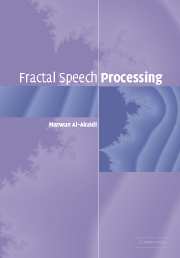Book contents
- Frontmatter
- Contents
- List of acronyms and abbreviations
- 1 Introduction to speech processing
- 2 Computational background
- 3 Statistical analysis, entropy and Bayesian estimation
- 4 Introduction to fractal geometry
- 5 Application to speech processing and synthesis
- 6 Speech processing with fractals
- 7 Speech synthesis using fractals
- 8 Cryptology and chaos
- Index
5 - Application to speech processing and synthesis
- Frontmatter
- Contents
- List of acronyms and abbreviations
- 1 Introduction to speech processing
- 2 Computational background
- 3 Statistical analysis, entropy and Bayesian estimation
- 4 Introduction to fractal geometry
- 5 Application to speech processing and synthesis
- 6 Speech processing with fractals
- 7 Speech synthesis using fractals
- 8 Cryptology and chaos
- Index
Summary
Segmentation of speech signals based on fractal dimension
Computer speech recognition is an important subject that has been studied for many years. Until relatively recently, classical mathematics and signal processing techniques have played a major role in the development of speech recognition systems. This includes the use of frequency-time analysis, the Wigner transform, applications of wavelets and a wide range of artificial neural network paradigms. Relatively little attention has been paid to the application of random scaling fractals to speech recognition. The fractal characterization of speech waveforms was first reported by Pickover and Al Khorasani [1], who investigated the self-affinity and fractal dimension for human speech in general. They found a fractal dimension of 1.66 using Hurst analysis (see e.g. [2]). In the present chapter, we investigate the use of fractal-dimension segmentation for feature extraction and recognition of isolated words. We shall start with a few preliminaries that relate to speech recognition techniques in general.
Speech recognition techniques
Speech recognition systems are based on digitizing an appropriate waveform from which useful data is then extracted using appropriate pre-processing techniques. After that, the data is processed to obtain a signature or representation of the speech signal. This signature is ideally a highly compressed form of the original data that represents the speech signal uniquely and unambiguously. The signature is then matched against some that have been created previously (templates) by averaging a set of such signatures for a particular word.
- Type
- Chapter
- Information
- Fractal Speech Processing , pp. 127 - 140Publisher: Cambridge University PressPrint publication year: 2004



